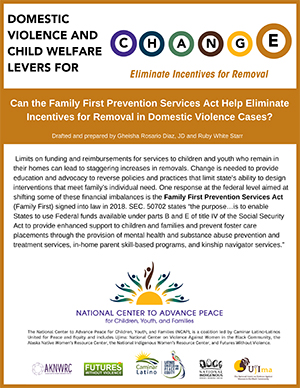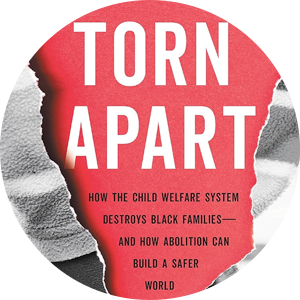 Commit to Antiracist Practice
Commit to Antiracist Practice
 Help Families with Actual Needs
Help Families with Actual Needs
 Advance Legal/Policy Protections
Advance Legal/Policy Protections
 Nurture Partnerships
Nurture Partnerships
 Generate Relevant Research
Generate Relevant Research
 Eliminate Incentives for Child Removal
Eliminate Incentives for Child Removal
The inflexibility of federal child welfare funding is a major contributor to the lack of available services for families. Current funding structures, that spend ten times more on foster care and adoption than on reuniting families, can perpetuate decision-making dictated by financial incentives for states to place children into foster care rather than providing services to keep families intact. For example, the largest source of federal funds for a state’s child welfare services come from Title IVE of the Social Security Act, distributes billions of dollars annually for foster care, adoption, and guardianship. States cannot, however, be reimbursed for services for children who remain in their homes. Education and advocacy are needed to delink these incentives and reverse policies and practices that limit states ability to design interventions that meet families individual needs.
A Tool to Create Change
Download a tool that provides relevant research to support improvements in systems and services to better meet the needs of survivors and their children.
Strategies to counter these challenges can include:
- Engage in public awareness campaigns to highlight the importance of supporting families in crisis and the need for flexible funding to address their unique needs
- Advocate for policy changes at the federal level to grant states more autonomy in designing interventions that prioritize family preservation and community-based support
- Work with lawmakers to explore alternative funding models that prioritize prevention and early intervention, reducing the reliance on foster care funding
- Encourage access to culturally affirming supports, affordable, accessible and safe housing, affordable childcare, and meaningful employment opportunities
- Work with child welfare agencies to develop programs that provide financial assistance, housing support, and mental health services to families at risk of separation
Resources
- Opportunities for Progress: Better Serving Families with Domestic Violence through the Family First Prevention Services Act
The Family First Prevention Services Act (FFPSA) of 2018 creates a new opportunity for child welfare and do- mestic violence agencies to strengthen their partnership and work together to better serve children and families. FFPSA marks a substantial movement toward child wel- fare reform by finally bringing child welfare financing into alignment with what research tells us is best for children and families—keeping children in their homes whenever safe and possible. This paper outlines the existing challenges within child welfare practice and highlights opportunities within FFPSA for advancing best practice for supporting children and families at the intersection of child welfare and domestic violence including through case practice models, selecting and implementing services that are grounded in domestic violence research, and utilizing state and local dollars to build evidence for innovative programs. - Opposing Family Separation Policies for the Welfare of Children
Child welfare interventions that result in the separation of children from their families are often accepted as necessary for the benefit and safety of the child. Annually, more than a quarter of a million children are removed from their parents by state governments. Yet 75% of substantiated child protection cases involve neglect, an amorphous category correlated and unfortunately too often confused with poverty. Most children involved in child welfare investigations and interventions are not victims of sexual and physical abuse. Studies indicate that apart from extreme cases of imminent physical harm to children, the family unit is the preferable place for children to grow and thrive. Suboptimal families are better for children than removal. Beyond a focus on outcomes for children, there is a moral imperative to keep families together and respect parents’ affirmative right to raise their children. - The Government Spends 10 Times More on Foster Care and Adoption Than Reuniting Families
It sounds like a conspiracy theory: The United States government incentivizes foster care placements and forced adoption over social support and reunification with birth families. It seems unreal, possibly even illegal, and not at all like something a responsible government would do. Unfortunately, it’s very real, and the root cause of many of the problems in child welfare cases. - Entangled Roots: The Role of Race in Policies that Separate Families
As a nation we separate children from their families on a routine basis. Sometimes, family separation is the deliberate result of government policy—as it is when child welfare agencies remove children from their parents’ custody over concerns for their safety and well-being. At other times, family separation is an unconsidered, if not quite unintended, consequence of policy—as it is in the immigration and criminal justice systems, when parents are incarcerated and sometimes deported without their children. In all cases, however, children suffer the consequences. Across the child welfare, immigration, and criminal justice systems, families of color are more likely to be separated, and children of color are more likely to experience the short-term distress and long-term trauma stemming from separation.
- Reimagining Child Welfare: Oregon’s Vision for Transformation
This episode features one jurisdiction moving from discussion to action. Oregon’s Child Welfare Division has released its Vision for Transformation, which documents a strategic roadmap to success, including specific guiding principles, strategies, and measurable outcomes. Listeners will hear from Rebecca Jones Gaston, the director of Oregon’s Child Welfare Division, on why the vision was developed, how it will be implemented, and the internal and external changes required to transform the State’s child welfare system into one that supports the individual needs of families and best serves Oregon's children and youth.
Topics discussed include the following:- The need to document within the Vision for Transformation that Oregon “recognize[s] that white supremacy and systemic racism are deeply embedded in the history, fabric, and institutions of our country, including child welfare systems.”
- How child welfare’s relationship with Tribal partners must evolve to align to the State’s vision for transformation
- The guiding principles of transformation:
- Supporting families and promoting prevention
- Enhancing staff and infrastructure
- Enhancing the structure of the system by using data with continuous quality improvement
-
Unpacking How Child Welfare and Foster Care Fail Black Children
In this country, child welfare and foster care break Black families apart. And it’s no surprise considering the child welfare system is, well, broken. Here's how.

